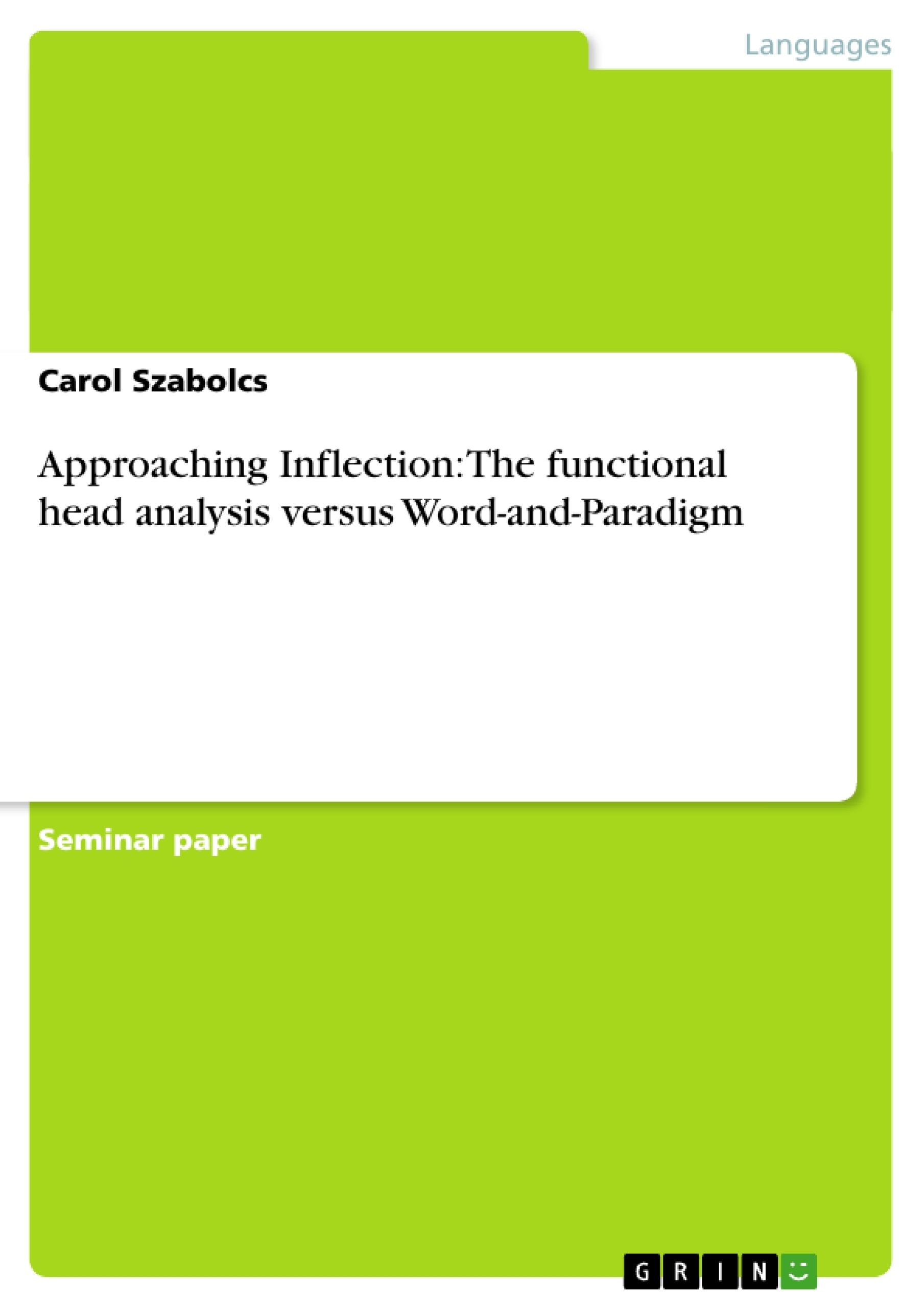A universal theoretical approach to inflection is just as difficult as the definition of inflection per se. Different theories have been provided over the past fifty years arguing and approaching inflection from a lexicalist or functionalist point of view. Other models that explain this linguistic process have been developed, too, as for example Distributed Morphology. In this work two approaches will receive closer attention: the functional head analysis of inflection and the Word-and-Paradigm model – two theoretical views to describe this as we shall see highly debated linguistic phenomena.
The aim is to contrast and discuss only two of the theories in detail, and hence, to argue in favour of a Word-and-Paradigm approach to inflection. Examples in this work will focus on the inflection of verbs only, since in my opinion the examination of verbs from these two angles will provide the most obvious and efficient arguments in preference of the second theoretical approach.
This paper is organized as follows: Section two will introduce the functional head approaches as proposed by Pollock (2006), Rivero (1990), and Speas (1990). The first two parts of this section will introduce the model for Modern English, Albanian and Modern Greek, and show how a tree-structured approach works on explaining inflection. In the third part Speas’ analysis of Navajo will present a strictly argumentative functional head approach. The end of the section will focus on the critics brought forward by Joseph and Smirniotopoulos (1993) on Rivero’s work.
Section three focuses on the Word-and-Paradigm approach to inflection as advanced in an early theoretical approach by Robins (1959) and followed by Matthews (1970, 1972) and Anderson (1977, 1982). The model itself, terms and conditions will be presented in the first part, followed by two examples: homophonous morphs in Latin (Bauer 1999) and cumulation in Georgian (Anderson 1982). These two examples will support a Word-and-Paradigm analysis instead of a functionalist analysis of inflection, by pointing at the weakness of the latter model.
Section four offers an advanced analysis with the Word-and-Paradigm model and will reload Rivero’s examples of Modern Greek verbs and show how Word-and-Paradigm provides a more favourable analysis following the critical answer to her article by Joseph and Smirniotopoulous (1993).
Section five will end with a preliminary conclusion on this paper.
Inhaltsverzeichnis (Table of Contents)
- Introduction.
- The functional head approach to inflection
- Pollock's functional analysis of Modern English and French verbs
- Rivero's analysis of verbs in Modern Greek and Albanian
- Speas' functional head approach to verbs in Navajo
- Exploded Inflectional Analysis - The rejection of the functional head approach to inflection
- The Word-and-Paradigm approach to inflection
- Word-and-Paradigm morphology as proposed by Matthews.
- Homophonous morphs
- Cumulation
- Reanalysing the Modern Greek verb pliikame.
- Conclusion.
Zielsetzung und Themenschwerpunkte (Objectives and Key Themes)
This paper aims to compare and contrast two theoretical approaches to inflection: the functional head analysis and the Word-and-Paradigm model. The primary focus is on the inflection of verbs, highlighting the strengths and weaknesses of each approach through detailed analysis of various languages, including Modern English, French, Modern Greek, and Albanian.
- Inflectional Morphology
- Functional Head Analysis
- Word-and-Paradigm Model
- Syntactic Processes in Inflection
- Theoretical Approaches to Linguistic Phenomena
Zusammenfassung der Kapitel (Chapter Summaries)
- Introduction: The paper introduces the topic of inflection and outlines the two contrasting theoretical approaches - the functional head analysis and the Word-and-Paradigm model. The paper focuses on the inflection of verbs and will argue in favor of the Word-and-Paradigm approach.
- The functional head approach to inflection: This section introduces the functional head analysis as proposed by Pollock, Rivero, and Speas. It examines how this model explains inflection in Modern English, Albanian, Modern Greek, and Navajo through a tree-structured approach. The section also presents critiques of the functional head approach by Joseph and Smirniotopoulos.
- The Word-and-Paradigm approach to inflection: This section outlines the Word-and-Paradigm model, tracing its development through the works of Robins, Matthews, and Anderson. It presents examples of homophonous morphs in Latin and cumulation in Georgian to support the Word-and-Paradigm analysis and highlight its strengths over the functionalist approach.
- Reanalysing the Modern Greek verb pliikame: This section provides an in-depth analysis of the Modern Greek verb pliikame using the Word-and-Paradigm model, offering a more favorable alternative to Rivero's functional head analysis and addressing the critiques raised by Joseph and Smirniotopoulos.
Schlüsselwörter (Keywords)
The main keywords and focus topics of this paper include inflectional morphology, functional head analysis, Word-and-Paradigm model, syntactic processes in inflection, theoretical approaches to linguistic phenomena, Modern English, French, Modern Greek, Albanian, and Navajo.
- Quote paper
- Carol Szabolcs (Author), 2007, Approaching Inflection: The functional head analysis versus Word-and-Paradigm, Munich, GRIN Verlag, https://www.grin.com/document/83489



